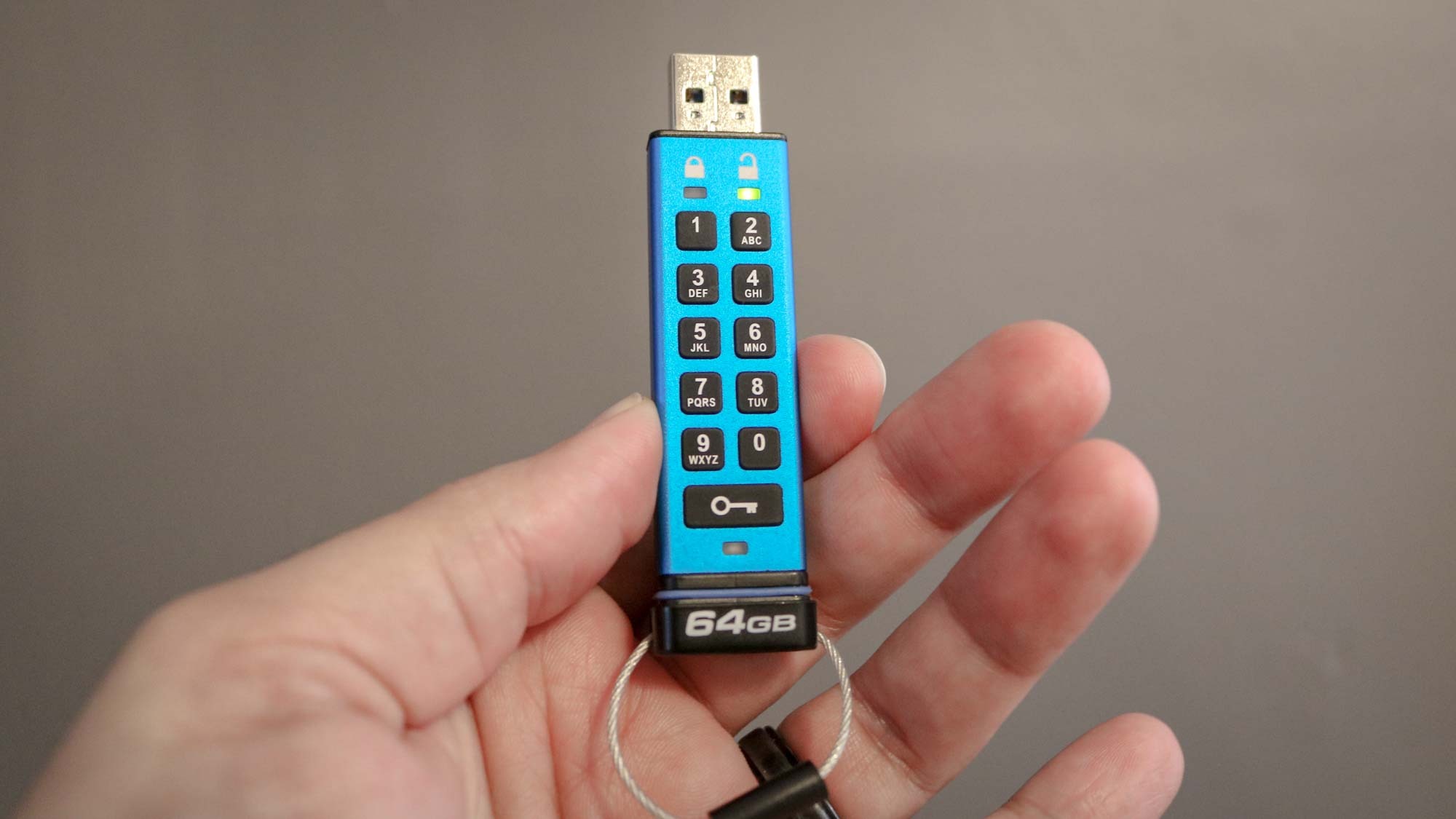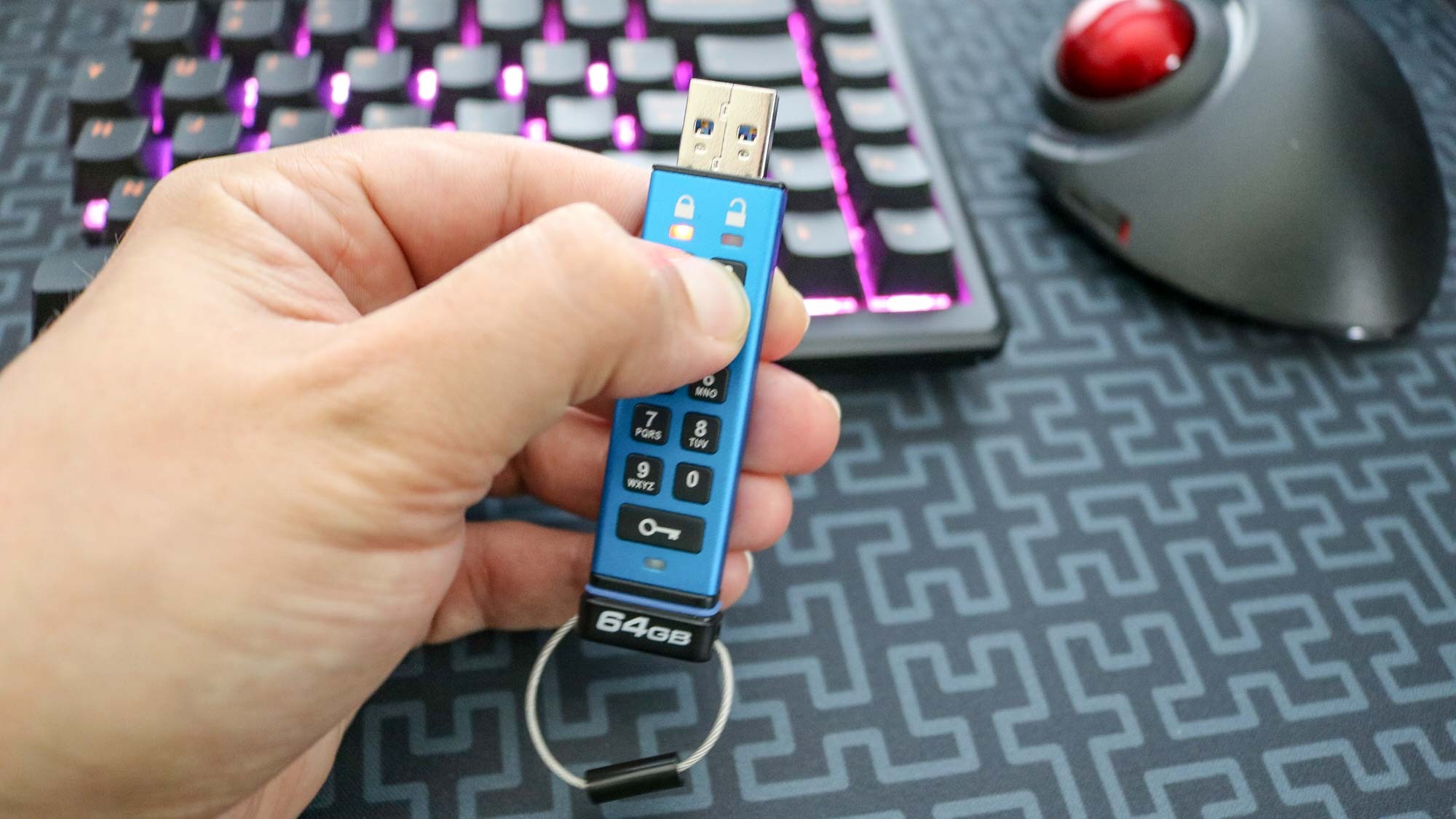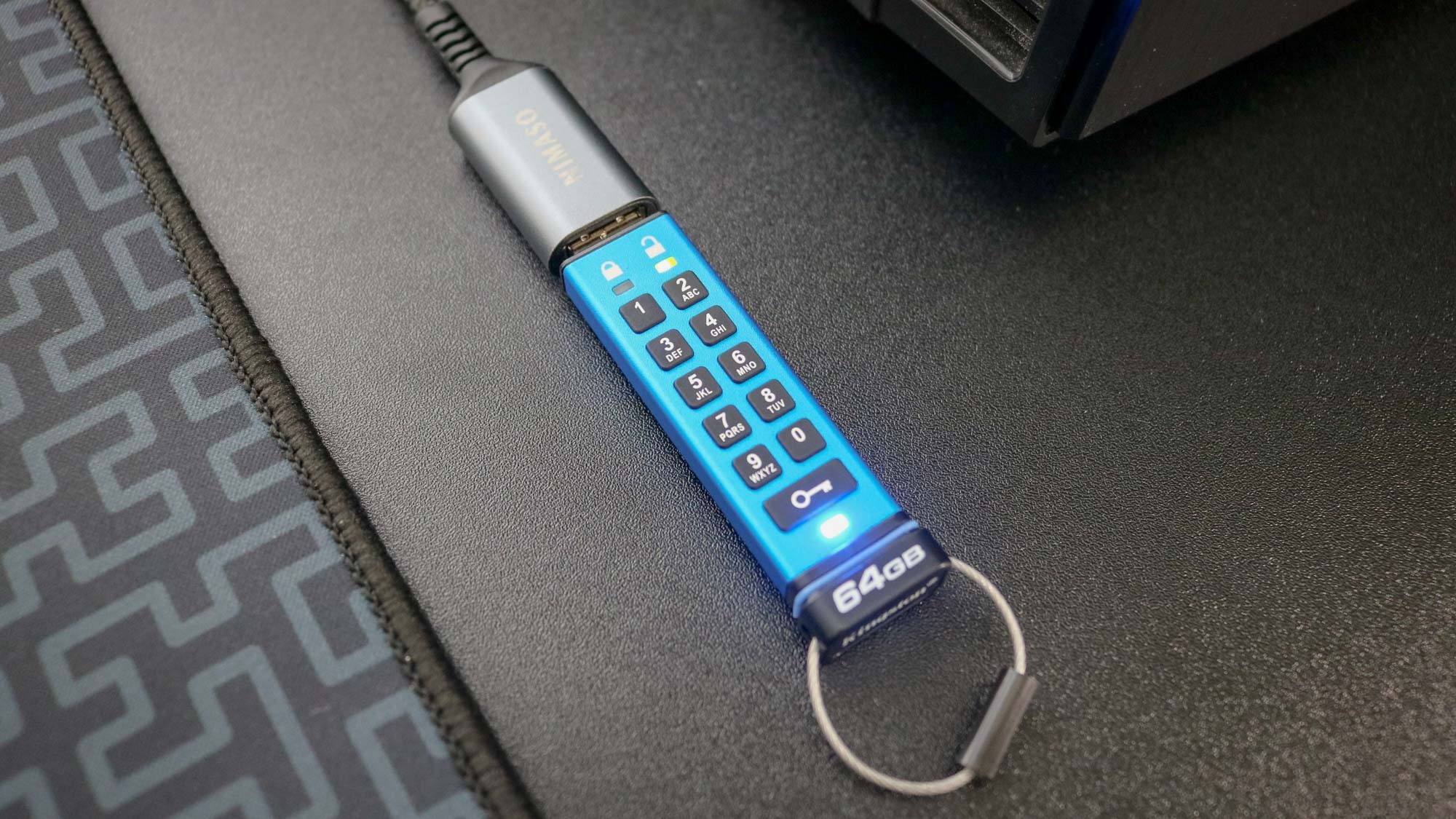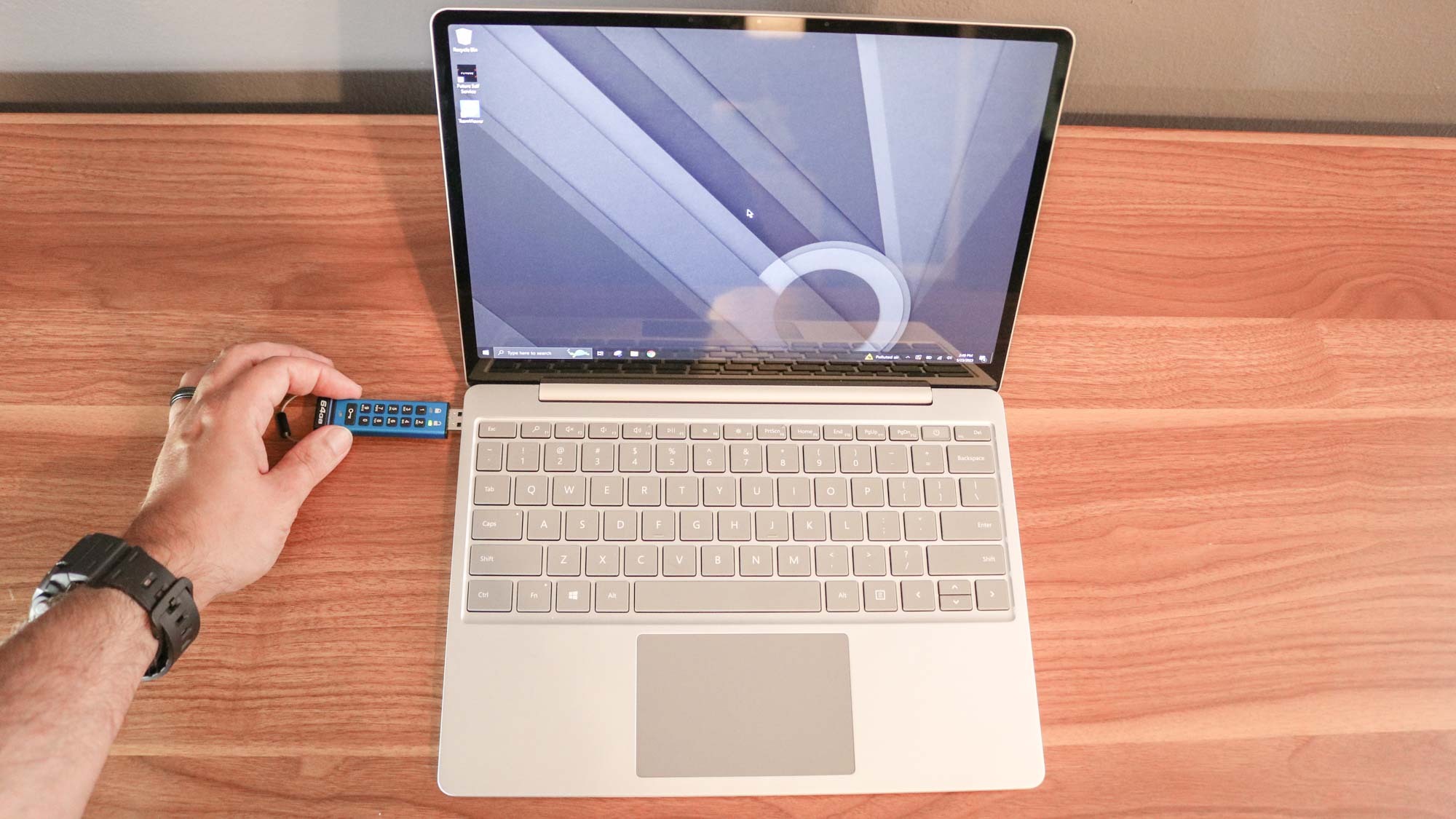I just tested this ultra-secure USB flash drive and now I feel like a spy
Military-grade security may be overkill but I’m partial to physical buttons

Even though most people now prefer storing their important files in the cloud, there are certain situations where storing them locally is the best option.
Although you can use an external hard drive for your larger files and one of the best USB flash drives for the smaller ones, if you happen to lose one of these drives, anyone can plug them into their computer to access your files.
This is where secure drives come in handy. Unlike a traditional flash drive or portable hard drive, they have extra security built in to safeguard your files. While this may be overkill for family photos or installation files you're moving between computers, for your most important files like travel documents, scanned copies of your birth certificate or financial documents, doing so is an excellent way to ensure they don’t fall into the wrong hands.
I spent the last week testing out the Kingston IronKey Keypad 200 ($75 , Amazon) which the company claims is the first drive that delivers military-grade security for consumer data. The device itself may be a bit on the excessive side for most people but I can’t get over how satisfying it is to press physical buttons to unlock a flash drive.
Adding an extra layer of security with a keypad

When it comes to securing your most important data, encryption is an absolute must. While software-based encryption is more common and cheaper to implement, it is susceptible to brute force attacks and as Kingston points out in a blog post, this approach is “only as safe as your computer.”
This is why the IronKey Keypad 200 and many other of Kingston’s secure drives use hardware-based encryption. Instead of entering a password on your computer, you need to physically enter a PIN on the device itself to unlock it. At the same time, for extra physical protection, it also comes with an aluminum outer shell that protects the drive against dust and makes it waterproof when submerged in up to three feet of water.
The IronKey Keypad 200 has XTS-AES 256-bit hardware-based encryption but it’s also FIPS 140-3 Level 3 (Pending). This certification comes with a few requirements including an 8 digit PIN, no factory-preset PIN being included with the device (you need to set one up yourself after you receive it) and periodic self-testing to ensure all of the built-in security features work. If something is amiss, the IronKey Keypad 200 will automatically shut down.
Get instant access to breaking news, the hottest reviews, great deals and helpful tips.
If you do misplace the IronKey Keypad 200, anyone trying to access the data you’ve stored on the device will have a really difficult time doing so. For starters, the device’s keypad is coated with a protective polymer layer that prevents others from analyzing any fingerprints left on its keys. Also, the circuits on the inside of this ultra-secure flash drive are coated with tamper-evident, tough epoxy. This makes it so that there’s no way to physically examine the drive’s circuitry without damaging it.
Finally, if the IronKey Keypad 200’s admin key is entered incorrectly 10 times in a row, Kingston’s built-in brute force attack protection will crypto-erase the drive — completely wiping its data while resetting the device. So don't forget your PIN.
No software necessary

As this was my first time setting up a hardware-encrypted flash drive with a numerical keypad, it did take some.
As there’s no pre-set User PIN, I had to come up with one on my own that needed to be between 8 to 15 digits in length with no repetitive numbers. Also, you can’t only use consecutive numbers like 1,2,3,4,5,6,7,8.

With my User PIN now set up, I have to press the KEY button once, enter my PIN and press the KEY button again to unlock the drive. There’s also a bit of visual feedback at the top of the IronKey Keypad 200 once the drive is unlocked as the red LED light under the lock icon turns off before a green LED light under the open lock icon turns on.
One of the best things about the fact that this drive has a keypad and uses hardware-based encryption is that you don’t need any software to lock or unlock it. It’s all done on the device itself and once unlocked, you can plug it into one of the best laptops or even a smartphone if you have a USB Type C to USB Type A adapter.
Overkill for most but an essential tool for others

For most people, an ultra-secure drive like the IronKey Keypad 200 won’t be necessary. However, for those that often find themselves handling sensitive data — especially on the go — this kind of flash drive can be a godsend.
For instance, journalists, politicians, lawyers and others who frequently handle sensitive data as part of their jobs can rest easy knowing that their precious data won’t fall into the wrong hands. Also, since the IronKey Keypad 200 doesn’t require any software to use, you can skirt having to go to your company’s IT department for approval.
I personally plan to use the IronKey Keypad 200 while traveling to keep a soft copy of all of my most important documents since you never know when having a scanned copy of your passport will come in handy.
At home though, I think it’s the perfect device for storing digital copies of your birth certificate, Social Security card, home title and other documents you may need if you happen to fall victim to identity theft. Sure, the best identity theft protection services can help you recover your identity but having an extra digital copy of your most important documents will certainly speed up this process.
If you’re in the market for an ultra-secure flash drive, you can’t beat the IronKey Keypad 200. Likewise, it would also make a cool gift for your geekiest friends and family. I know for me, while using it, I felt more like a spy than I ever have before.

Anthony Spadafora is the managing editor for security and home office furniture at Tom’s Guide where he covers everything from data breaches to password managers and the best way to cover your whole home or business with Wi-Fi. He also reviews standing desks, office chairs and other home office accessories with a penchant for building desk setups. Before joining the team, Anthony wrote for ITProPortal while living in Korea and later for TechRadar Pro after moving back to the US. Based in Houston, Texas, when he’s not writing Anthony can be found tinkering with PCs and game consoles, managing cables and upgrading his smart home.
